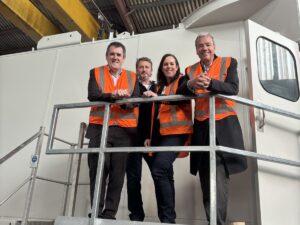Reducing manufacturing emissions
Hon Andrew Bayly, Minister of Manufacturing
Manufacturing is a significant sector for New Zealand. It employs 230,000 people and accounts for nearly 10 per cent of GDP and 60 per cent of exports. I often describe it as a “sleeping giant” for New Zealand’s economy, because its significance is not well understood.
When I travel around the country promoting the manufacturing sector, one of the things I often remind people is that a career in manufacturing is a career in a highly advanced, technical field.
A lesser-known fact is that approximately a quarter of all New Zealand’s business-led research and development comes from the manufacturing sector, meaning manufacturing is a key driver of innovation.
However, to support this innovation, manufacturers need the right tools and resources.
I know from talking to manufacturers that access to information and expert guidance on how to upskill and improve productivity is challenging. Which is why I was delighted to recently launch a set of tools to help empower manufacturers to grow their business and reduce their emissions.
Emissions and waste mapping
The first is a report that identifies and maps the manufacturing sector’s emissions and waste patterns. Titled ‘Mapping Emissions and Waste Stream Profiles, and Opportunities for Achieving Net-Zero Circular Advanced Manufacturing’, the report is based on waste and emissions data from 2019 (the most recent data available).
It provides a comprehensive picture of waste, emissions, and opportunities to improve sustainability across the seven main manufacturing subsectors: food and beverage, machinery and equipment, other manufacturing, metal and metal products, chemicals and refining, wood and paper, and plastics and rubber.
The report details challenges and opportunities for the sector with a goal of helping manufacturers identify opportunities to adopt low-emissions technology and increase circular manufacturing practices which, in turn, will help us reduce our net greenhouse gas emissions.
While this report details some challenges for the sector – such as significant supply chain emissions, and many subsectors’ dependence on imports which then ‘offshore’ their emissions – it also highlights many opportunities.
These include reducing risk and cost, more resilient supply chains, better use of waste as inputs, meeting customer demand, extending service lives, the three R’s (reuse, reduce, repair) and improved brand and relationships.
Barriers exist around access to capital, risks with emerging technologies and approaches, lack of knowledge, and lack of central standardised waste data.
The demand for low-carbon-manufactured products is increasing globally, and New Zealand is in a strong position to take advantage of this through our agile and innovative manufacturers and relatively low-carbon electricity grid.
There are many examples of our manufacturers already innovating in this way. For example, I understand there is a company making gumboots in Wellington that collects old gumboots from companies that use a lot of this product, like meat works. They then shred them up into small pellets and turn them into new gumboots. This is 100 per cent gumboot-to-gumboot manufacturing!
Reducing waste through adopting circular economy principles will also increase efficiency in our resource use and ease supply-chain pressures.
Climate action toolbox
The second tool is the Climate Action Toolbox’s Manufacturing Pathway, which includes an emissions calculator to help businesses set targets and monitor progress.
A two-minute assessment, based on simple information about a manufacturer’s business, provides tailored recommendations of areas to focus on. Manufacturers can browse the priority areas to focus on actions that would make the biggest difference or choose from suggested ‘quick wins’ to get going straight away.
Designing products, site operations, manufacturing processes, and moving goods are all likely to be priority areas. The Toolbox suggests actionable changes across these topics, with information on the benefits, steps to follow, links to helpful resources, and case studies from other businesses that are leading the way.
Providing businesses with the tools to grow and innovate is a key part of our Government’s Climate Strategy. We will not accept shutting down productive sectors of the economy to meet emissions targets. Instead, we are committed to an innovation and technology-led approach which enables production to increase as our emissions come down.
We need businesses to grow and thrive because without businesses the Government has no income, and without an income we cannot invest in the public services New Zealanders rely on every single day.
To have a world class education, health and transport system, we must have world-class businesses that export and compete on the world stage.
I truly believe the manufacturing sector has a vital role to play in building a sustainable and prosperous future for all New Zealanders.
The Climate Action Toolbox can be accessed at www.tools.business.govt.nz/climate
Hon. Andrew Bayly is the Minister for Manufacturing in the National-led Coalition Government; he can be contacted at andrew.bayly@parliament.govt.nz



